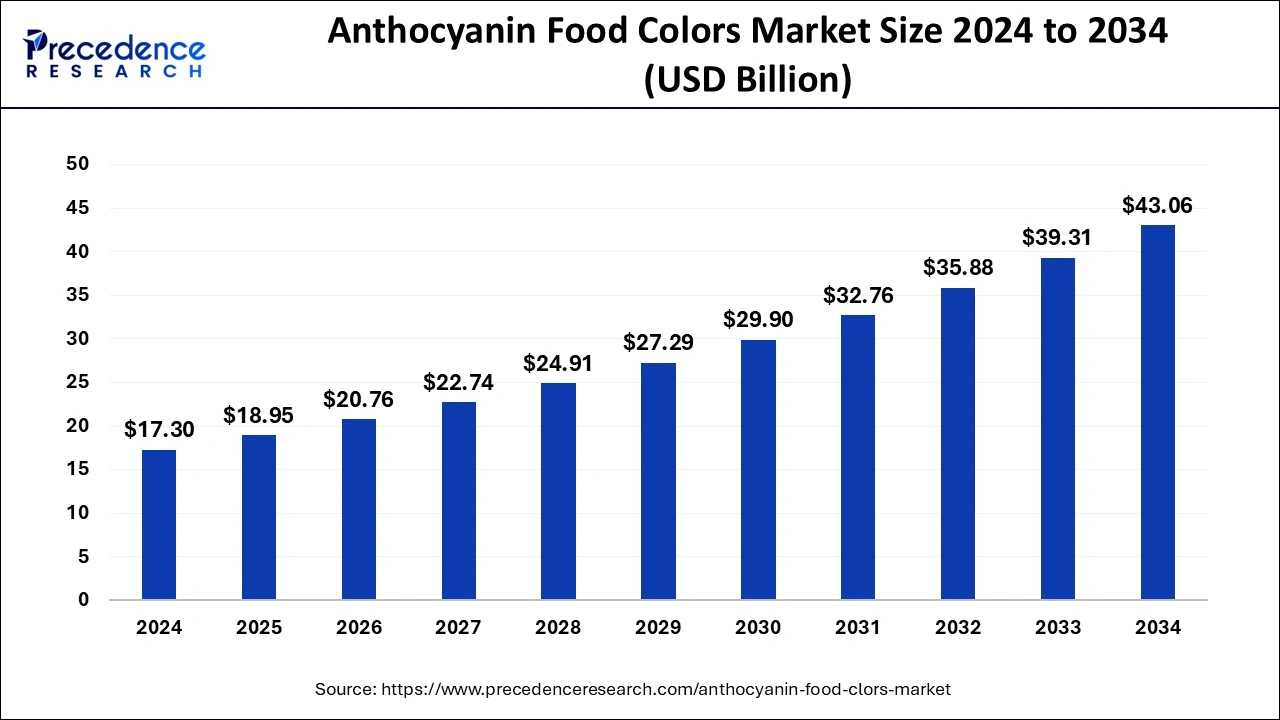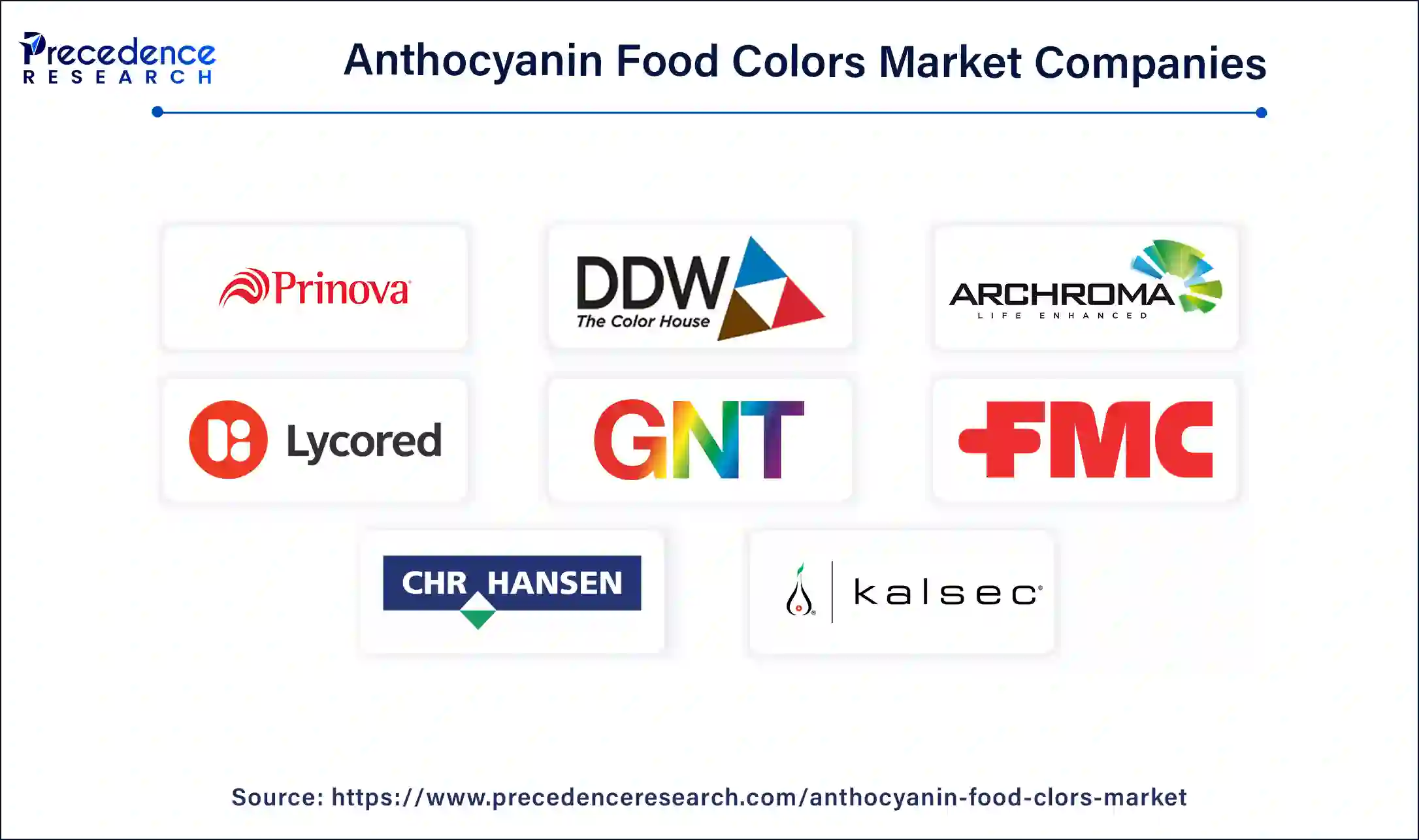January 2025
The global anthocyanin food colors market size is calculated at USD 18.95 billion in 2025 and is forecasted to reach around USD 43.06 billion by 2034, accelerating at a CAGR of 9.55% from 2025 to 2034.
The global anthocyanin food colors market size accounted for USD 17.30 billion in 2024 and is expected to exceed around USD 43.06 billion by 2034, growing at a CAGR of 9.55% from 2025 to 2034. The anthocyanin food colors market is on the rise because of the rising trends of natural and clean label colors, increasing attention toward healthy plant-based products, and the growing uses of anthocyanins in different food processing applications also significantly contribute to market expansion.

Artificial intelligence integration is promoting innovations and efficiency in the manufacture of anthocyanin food colors market and several other segments. The technologies available enhance the extraction process, reduce cost, and enhance sustainability. AI is also in the process of assisting with product formulation through the evaluation of the consumers’ preferences and tendencies, thereby allowing food producers to create foods with anthocyanin-based colors. Further, AI helps to maintain quality since it maintains the intensity and safety of the products.
Anthocyanin food colors are flavonoid pigments present in fruit, vegetables, and flowers, contributing red, blue, and or purple colors. The common sources are berries, red cabbage, grapes, hibiscus, black rice, and other plants. They are not only responsible for their color but also provide health benefits that anthocyanins are antioxidants. Opportunities for growing the anthocyanin food colors market due to the expanding food and beverage sector, developing new extraction and purification technologies, and exploring novel applications in cosmetics and pharmaceuticals.
The anthocyanin food colors market is growing due to rising customer awareness of the health benefits of antioxidants, increasing demand for natural colorants in the food and beverages industry, and a shift towards plant-based products. Major factors that fuel the growth of anthocyanin food color are the demand for natural and clean label colors, awareness of health benefits associated with anthocyanins, and trends towards plant-based foods and beverages.
| Report Coverage | Details |
| Market Size by 2024 | USD 17.30 Billion |
| Market Size in 2025 | USD 18.95 Billion |
| Market Size in 2034 | USD 43.06 Billion |
| Market Growth Rate from 2025 to 2034 | CAGR of 9.55% |
| Dominating Region | North America |
| Fastest Growing Region | Asia Pacific |
| Base Year | 2024 |
| Forecast Period | 2025 to 2034 |
| Segments Covered | Type, Source, Application, Distribution Channel, and Regions |
| Regions Covered | North America, Europe, Asia-Pacific, Latin America, and Middle East & Africa |
Rising health awareness
The anthocyanin food colors market is on the rise due to the increasing consumer taste for natural product dyes. This trend is reinforced by regulatory demands and clean label trends, which are associated with clear and simple food labeling and declaration of its ingredients. The awareness among consumers is gradually increasing and is leading to the change towards healthier and more natural foods. The antioxidants have been shown to decrease risks of heart diseases, different cancers, and neurological disorders. The demand for anthocyanin food colors has increased customer concern with cleaner and natural food labels.
Cost constraints
A major limitation in the anthocyanin food colors market is the high production cost related to extracting natural anthocyanins, which influences the pricing strategy and market competitiveness. Further, there is a limited supply of raw materials since anthocyanins are mainly sourced from specific fruits and vegetables, which restricts the supply chain. Stability is another drawback of anthocyanin pigments since they are sensitive to pH level and temperature fluctuations, and light exposure can frequently influence their usage in different types of food products.
Newer methods and technologies
Newer extraction techniques have made the process far easier and highly possible to utilize anthocyanins as a natural food color. The recent advancements in extraction methods provide efficient extraction with minimum time and with less harsh solvents. Furthermore, high-pressure processing (HPP) is a newly developed technique for the extraction of anthocyanin from plant materials by pressure, which is a non-toxic method with higher efficiency. These innovations enhance the profitability of the anthocyanin food colors market and increase the preservation of the active compounds and color of pigments, thus expanding the application of extracts in various foods.
The powder segment led the global anthocyanin food colors market in 2024. Powder anthocyanin food colors are the most popular type of anthocyanin food colors used in the food and beverage industry. The color comes from drying an anthocyanin-containing fruit or vegetable. Powder anthocyanin is user-friendly; it can be blended into many kinds of food, especially in drinks. It is easy to store and measure and can be incorporated into different food products; hence, it will be useful in both commercial and domestic sectors. Powdered food colors have a longer shelf life than liquid or gel forms, providing better stability and reducing the risk of spoilage.
The liquid segment is projected to witness the fastest growth in the anthocyanin food colors market during the forecast period. Anthocyanins are flavonoids, which are water-soluble pigments that fall under phenolic compounds. Anthocyanins that generate color, shades of red, purple, and blue, are present in fruits and vegetables. The liquid form of anthocyanin food colors is on the rise, specifically due to their convenience. Its advantage is that working with liquid material enables it to achieve varying intensities of color and make it darker or lighter easily. Furthermore, the liquid form of anthocyanin is soluble in food media, and it is evenly distributed in the food matrix. This makes it suitable for any type of food that should have a longer shelf life, and some of the products include biscuits and sauces.
The grapes segment noted the largest share of the anthocyanin food colors market in 2024. Anthocyanins are a class of water-soluble pigments and phenolic compounds that are incorporated within the group of flavonoids. They are produced in grape berries during ripening and in the leaves at the final stage of plant development. Anthocyanins are the main natural pigments in grapes and wines and are used as a food additive, i.e., a colorant. Anthocyanidins are water-soluble pigments occurring as red, purple, or blue pigments that are common in grapes and other fruits and veggies. Grape skin extract is one of the most prevalent sources of anthocyanins, and its content varies depending on the grape’s ripeness. It is produced by distillation of grape marc, which is the solid residue after grapes have been crushed and the juice extracted.
The beverage segment dominated the global anthocyanin food colors market in 2024. The demand for anthocyanin food colors arises from its health effects, such as the antioxidant effect on foods, apart from making them colorful. Used in beverages, confectionery, dairy products, and baked products, which are favored by consumers to cherish their health. They are anthocyanidins, which are water-soluble pigments occurring naturally and responsible for the red, blue, and purple colors of fruits, vegetables, and flowers. Anthocyanins have applications in many food products and drinks, such as soft drinks, jams, jellies, confectioneries, bakery and dairy products, and powders. They are also applied in confectionery, desserts, ice cream, fructifications, sherbet, ices, pops, yogurts, gelatine products, and candies.
The supermarkets segment contributed the largest share of the anthocyanin food colors market in 2024. The demand for anthocyanin food color is increasing, especially because consumers are shifting their preferences to natural food dyes. Food coloring from fruits and vegetables such as berries and grapes- anthocyanin is rich in bright shades and has benefits such as containing antioxidants and anti-inflammatory effects. Supermarkets are the sources of products that contain anthocyanin-sourced color to tap the emerging clean-label business. These colors are applied in many types of foods, such as drinks, sweet foods, and processed foods as snacks. It may be predicted that as the concern among consumers and approval by the regulatory authorities, the market for anthocyanin food colors will rise.
North America accounted for the largest share of the anthocyanin food colors market in 2024. The growth of packaged and processed products within the region has been a key driver of the market. Added food colors are very common in processed foods because most of them lose color during processing or may not have the attractive color needed. Hence, there is a continued demand for food colors to enhance the attractiveness of processed foods, as consumers look for long convenience and a variety of foods to eat.
The U.S. has developed a food processing sector that leads the region. The need for clean-label products and natural ingredients increases the market’s demand. Additional market factors include regulatory support for natural colorants that improve their market outlook. In addition, sophisticated extraction technologies are available in combination with constant R&D in the United States.
Asia Pacific is anticipated to witness the fastest growth in the anthocyanin food colors market during the forecasted years. Furthermore, the use of the product in the production of alcoholic and non-alcoholic spirits is likely to be responsible for market growth. There is an increasing trend in India to look for natural and organic products which has brought a revolution in the processing food industry. This trend is particularly well evident in the food and beverage sectors since anthocyanins are finding their application as natural dyes.

By Type
By Source
By Application
By Distribution Channel
By Geography
For inquiries regarding discounts, bulk purchases, or customization requests, please contact us at sales@precedenceresearch.com
No cookie-cutter, only authentic analysis – take the 1st step to become a Precedence Research client
January 2025
January 2025
September 2024
October 2024